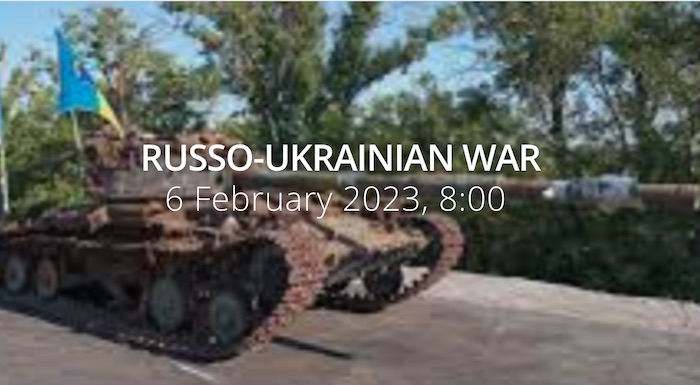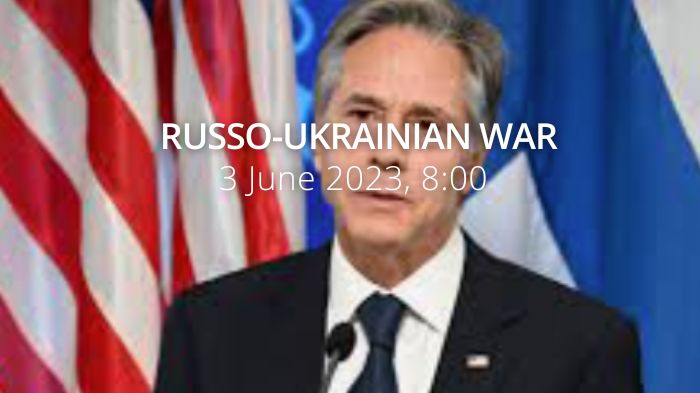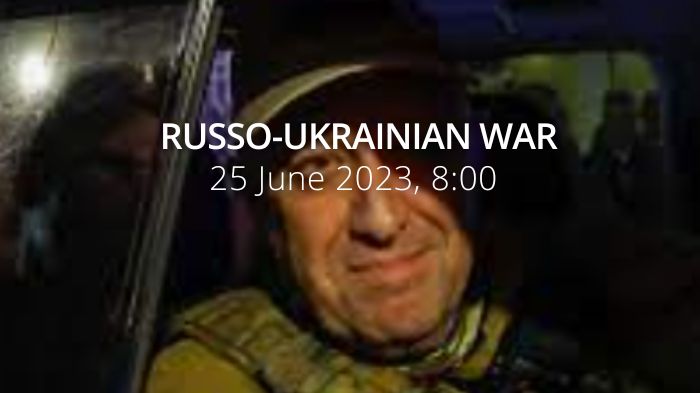Four Russian jets conduct airstrike on Kherson Oblast, dropping five guided bombs. Italian Minister of Defense criticized by Ukrainian officials for “pro-Russian peacekeeping.”A special edition campaign assessment by Institute of Study of War.
https://twitter.com/EuromaidanPress/status/1650324932864163840
Daily overview — Summary report, April 24
A map of the approximate situation on the ground in Ukraine as of 00:00 UTC 24/04/23.
There have been no notable changes to control since the last update. pic.twitter.com/CxQERXDhm0
— War Mapper (@War_Mapper) April 24, 2023
The General Staff’s operational update regarding the Russian invasion as of 18.00 pm, April 24, 2023 is in the dropdown menu below:
Military Updates
Frontline update: Russians attempted several attacks south of semi-surrounded Avdiyivka in Donbas with small gains.
The situation remains stable north of Avdiyivka, the city where Russians use the same tactic as in Bakhmut. https://t.co/f23cchllz1 pic.twitter.com/qNjK7nFM0O
— Euromaidan Press (@EuromaidanPress) April 23, 2023
Over 50 instances of destruction documented in Donetsk Oblast due to recent shelling. More than fifty destroyed buildings have been documented following Russian shelling in six towns and villages across Donetsk oblast over the past day. Among the most severely affected areas were Avdiivka, Bakhmut, Vuhledar, Kostiantynivka, Novomykhaylivka and Karlivka, according to the police department of Donetsk Oblast. Two air bombs were dropped on Vuhledar, damaging a residential building and a car. Four S-300 rockets were fired at Kostiantynivka, resulting in damage to seven private houses and infrastructure, as well as seven cars. Meanwhile, 20 private houses were damaged in Bakhmut, and one civilian was injured. In addition, 15 private houses were destroyed in Novyi New York. In the early hours of the morning, Russian armed forces launched a missile strike on Sloviansk, damaging two private residences. No injuries were reported.
Over 50 buildings destroyed in six towns and villages in Donetsk oblast following Russian shelling, according to police department. Avdiyivka, Bakhmut, Vuhledar, Kostiantynivka, Novomykhaylivka, and Karlivka are among the worst affected areas https://t.co/rRBtTq6uHF pic.twitter.com/n2VnHc9PZk
— Euromaidan Press (@EuromaidanPress) April 23, 2023
Russian Navy in the Black Sea has decreased from 10 to 7 ships today – Ukrainian Armed Forces Navy. As of 13:00 on April 23, only 7 Russian Navy ships, including two missile carriers with a total of 8 Caliber missiles, are currently on duty in the Black Sea, according to the Ukrainian Navy, Ukrainian Armed Forces Navy reports. Earlier, it was reported that there were 10 Russian ships in the Black Sea.
Russian Su-35 jets have conducted an aviation bombing strike on Kherson district, dropping 5 KAB-500 bombs from four planes
No human casualties reported, but private homes damaged. Lancet drones also attacked area, 4 of which were destroyed by UA forces https://t.co/nVKK1j3E2d pic.twitter.com/0ftdfbQ9nU
— Euromaidan Press (@EuromaidanPress) April 23, 2023
Four Russian Su-35 jets conduct airstrike on Kherson district with KAB-500 bombs. Russian occupiers conducted an aviation bombing strike with Su-35 aircraft on the Kherson district, according to the Operational Command South of Ukraine’s forces. It is reported that the Russians dropped five KAB-500 bombs from four planes. Private residential houses were damaged, but according to the military, there were no human casualties. In addition, the area was attacked by the “Lancet” drones.
Ukrainian forces might have established positions on the east bank of Dnipro in Kherson Oblast.m Ukrainian forces have established positions in the east bank of Dnipro in Kherson Oblast, as the Institute for the Study of War has reported as of 22 April 2023, referring to new geolocated footage and Russian sources. The scale of Ukrainian presence on the east bank of Dnipro remains unclear, but Ukrainian troops established stable supply lines to these positions.
"Give us weapons and we will end it [the war]," Ukrainian soldier who was fighting in Bakhmut said.
Ukrainian servicemen we spoke to emphasized the lack of ammunition for mortars and grenade launchers to repel Russian attacks. Read more here: https://t.co/bfJM3XWWYe pic.twitter.com/5qoOZThAVC
— Euromaidan Press (@EuromaidanPress) April 24, 2023
According to British Defence Intelligence, (last 48 hours):
- The authorities in occupied areas of Ukraine are almost certainly coercing the population to accept Russian Federation passports. Residents in Kherson have been warned that those who have not accepted a Russian passport by 01 June 2023 will be ‘deported’ and their property seized.
- Russia is using passports as a tool in the ‘Russification’ of the occupied areas, as it did in Donetsk and Luhansk before the February 2022 invasion.
- Russia is likely expediating the integration of the occupied areas of Ukraine into the bureaucracy of the Russian Federation to help paint the invasion as a success, especially in the run-up to the 2024 presidential elections.
Losses of the Russian army

Humanitarian
This is what the “Russian world” brings in its wake.
Avdiyivka and Kramatorsk, March 2023
Photo: Aris Messinis#StandWithUkraine pic.twitter.com/gAoNUp9IyT
— Euromaidan Press (@EuromaidanPress) April 24, 2023
Ukrainian art festival Bouquet Kyiv Stage 2023 to be held in Tbilisi. According to the organizing committee, holding Bouquet Kyiv Stage in Tbilisi will express gratitude to the freedom-loving segment of the Georgian population known as Kartveli. This year’s festival slogan is “Ukraine + Sakartvelo, side by side.”
Legal
#Russia seizes another #Ukraine citizen in occupied #Crimea on unprovable ‘sabotage’ charges#Serhiy_Horiunov #LetMyPeopleGo #StandWithUkraine #StopRussiahttps://t.co/uRnaPYLE65
— Euromaidan Press (@EuromaidanPress) April 23, 2023
Crimean Tatar was sentenced to 7 years of imprisonment in occupied Crimea for lending UAH500 to his friend from Ukrainian army. “The Kyiv Simferopol District Court,” which is under the control of the Russian Federation in occupied Crimea, sentenced the Crimean Tatar Appaz Kurtamet to 7 years of imprisonment for allegedly transferring 500 hryvnias to the Ukrainian volunteer battalion “Crimea.” On 22 July 2022, Kurtamet was detained by Russian security forces in the occupied Ukrainian city of Henichesk. From there, he was sent to a filtration camp, in which, during a phone check, it turned out that an acquaintance of Kurtamet, to whom he had lent UAH 500, was serving in the Ukrainian volunteer battalion “Crimea.” Russian FSB investigators filed his loan as “financing of an illegal armed formation.”
Support
Cyprus freezes assets of individuals accused by US & UK of helping Russian oligarchs evade sanctions
4,000 non-EU residents with Russian passports informed that their accounts will be closed. 13 individuals &several Cypriot companies' have accounts frozen https://t.co/xWn6egIKYc
— Euromaidan Press (@EuromaidanPress) April 23, 2023
Ukraine needs fighter jets and long-range missiles to support a counteroffensive, but allies are unwilling to provide them — deputy Foreign Minister. Ukraine needs fighter jets and longer-range missiles like ATACMS to support a counteroffensive, but allies are currently unwilling to provide them, Ukraine’s Deputy Minister of Foreign Affairs Andriy Melnyk stated on the TV air, Liviy Bereh reports. He noted that the help that Ukraine’s allies promised to provide at the meeting in the Ramstein format is insufficient for a counteroffensive. Air defense systems are crucial for Ukraine, but it is not about defense or offensive. And for offensive operations, fighter jets are primarily needed to support the offensive.
Ukraine and France to strengthen cooperation in the transportation sector. Ukraine and France have signed a memorandum of understanding on transport cooperation, as reported by European Pravda, referencing the Ministry of Infrastructure press release. Deputy Prime Minister for Restoration of Ukraine, Oleksandr Kubrakov, Clément Beaune, the Minister Delegate for Transport of France, and Pierre Heilbronn, the Special Envoy of the French President for Ukraine’s relief and reconstruction, participated in the 22 April signing ceremony.
Ramstein-11 outcomes: Russia approaching Nuremberg II – Defense Minister Reznikov. The 11th meeting of the Ukraine Defense Contact Group held on 21 April at Ramstein Air Base in Germany, brought Russia closer to a Nuremberg-type tribunal, as stated by Ukraine’s Defense Minister Oleksiy Reznikov on Twitter about the meeting outcomes.
New Developments
Multiple Russian, Chinese, and Iranian state media outlets on Twitter simultaneously began to gain followers after months of decline or stagnation
This is the outcome of Twitter's change in policy regarding state media. https://t.co/GJduMEZIgE pic.twitter.com/vn7IBNFurI
— Euromaidan Press (@EuromaidanPress) April 24, 2023
Cyprus imposes sanctions on individuals accused of helping Russian oligarchs evade sanctions.” Cyprus has imposed sanctions on individuals accused by the United States and Britain of helping Russian oligarchs evade sanctions imposed on Moscow over the war in Ukraine. According to AFP, financial commissioner of Cyprus, Pavlos Ioannou, announced that the assets of corresponding physical and legal persons have been frozen. The Greek-language daily newspaper in Cyprus, “Phileleftheros,” reported that the island’s largest creditor, the Bank of Cyprus, also “informed 4,000 clients who have Russian passports and are not EU residents that their accounts will be closed.”
Ukraine adopts law that condemns Russian Imperial policy and decolonizes toponyms. On 21 April 2023, Ukrainian President Volodymyr Zelensky signed a law condemning and banning the propaganda of Russian imperial policy in Ukraine and decolonizing toponyms, including the names of streets, towns, cities, and other places. Ukrainian Parliament adopted the law a month before on 21 March 2023. The law is titled “On Amendments to the Law of Ukraine ‘On Geographical Names’ concerning the Decolonization of Toponyms and the Regulation of the Use of Geographical Names…”
Italian Minister of Defense criticized by Ukrainian officials for “pro-Russian peacekeeping.” Italian Minister of Defense Guido Crosetto said in his interview with La Stampa that, regarding the Russo-Ukrainian war, Italy is moving along two main lines. “The first is that of aid: we must guarantee Ukraine’s right to defend itself. But on the other, there is a constant and daily commitment to try to build a table for peace. Because now the only thing we can try to do is not to end the war but to bring two sides to the same table. They do not speak to each other and have nothing in common.”
Assessment
https://www.understandingwar.org/backgrounder/russian-offensive-campaign-assessment-april-23-2023*
- On the war.
The Institute for the Study of War has made the following assessment as of April 23, 2022:
ISW is publishing a special edition campaign assessment today, April 23. This report outlines the current Russian order of battle (ORBAT) in Ukraine, assesses the offensive and defensive capabilities of Russian force groupings along the front, and discusses major factors that may complicate Russian defensive operations in the event of a Ukrainian counteroffensive.
This report is based on a number of assumptions about Ukrainian capabilities that ISW does not, as a matter of policy, attempt to assess or report on. It assumes, in particular, that Ukraine will be able to conduct a coordinated multi-brigade mechanized offensive operation making full use of the reported nine brigades being prepared for that operation. That task is daunting and larger than any offensive effort Ukraine has hitherto attempted (four Ukrainian brigades were reportedly used in the Kharkiv counter-offensive, for example). It also assumes that Ukraine will have integrated enough tanks and armored personnel carriers of various sorts into its units to support extended mechanized maneuver, that Ukrainian mechanized units will have sufficient ammunition of all sorts including artillery, and that Ukraine will be able to conduct long-range precision strikes with HIMARS and other similar systems integrated with and supporting maneuver operations as it has done before. It further assumes that Ukrainian forces will have the mine-clearing and bridging capabilities needed to move relatively rapidly through prepared defensive positions. ISW sees no reason to question any of these assumptions given the intensity with which Ukraine has reportedly been preparing for this operation and the time it has taken to do so, as well as the equipment reportedly delivered to Ukrainian forces by Western countries. If any significant number of these assumptions prove invalid, however, then some of the assessments and observations below will also be invalid, and the Russians’ prospects for holding their lines will be better than presented below. ISW offers no assessment of or evidence for these assumptions, and thus offers no specific forecast for the nature, scale, location, duration, or outcome of the upcoming Ukrainian counter-offensive. Ukraine has attractive options for offensive operations all along the line, and ISW does not assess that the information presented in this report or any observations ISW has made below lead obviously to the conclusion that Ukrainian forces will attack in one area or another.
Russian forces in Ukraine are operating in decentralized and largely degraded formations throughout the theater, and the current pattern of deployment suggests that most available units are already online and engaged in either offensive or defensive operations. ISW assesses that Russian forces are currently operating along seven axes: Kupiansk; Luhansk Oblast; Bakhmut; Avdiivka-Donetsk City; western Donetsk/eastern Zaporizhzhia; western Zaporizhzhia; and Kherson Oblast. Russian forces are pursuing active offensive operations on at least five of these axes (Kupiansk, Luhansk, Bakhmut, Avdiivka-Donetsk City, and western Donetsk/eastern Zaporizhzhia) and predominantly pursuing defensive operations on the western Zaporizhzhia Oblast and Kherson Oblast axes. The forces currently committed to both offensive and defensive operations in Ukraine are both regular (doctrinally consistent based on Russian pre-war units) and irregular (non-standard and non-doctrinal) forces, and it is highly likely that the majority of Russian elements throughout Ukraine are substantially below full strength due to losses taken during previous phases of the war. This report will discuss “elements” of certain units and formations deployed to certain areas, but it should not be assumed that any of these units or formations are operating at full strength.
Kupiansk Axis (Northeastern Kharkiv Oblast)
Russia has committed elements of previously damaged Western Military District (WMD) formations to the Kupiansk area. Russian forces have been pursuing limited offensive operations on the Kupiansk axis in the first few months of 2023, but have failed to make operationally significant gains towards Kupiansk and have made only occasional and localized tactical gains. ISW has observed mentions of unknown units of unspecified echelon of the 1st Guards Tank Army (1st GTA)’s 47th Tank Division operating in the Kupiansk direction.[1] The 1st GTA notably suffered major manpower and equipment losses during the Russian offensive in Chernihiv Oblast early in the war in 2022, and then once again during Ukraine’s Kharkiv Oblast counteroffensive in fall 2022.[2] The 1st GTA’s 4th Tank Division, particularly its 12th and 13th Tank Regiments, lost nearly 100 tanks in a few days in September 2022, so any constituent elements of the 1st GTA that are currently operating near Kupiansk are likely short of tanks and other critical systems.[3] The commitment of damaged and understrength 1st GTA elements to this line likely suggests that the Russian military command is not immediately prioritizing this as an axis of advance or defense. Geolocated footage from February 2023 additionally shows that the WMD’s 6th Combined Arms Army (CAA) has committed unknown units of unspecified echelon near the Fyholivka-Novomlynsk area, about 19km directly north of Kupiansk.[4] A Russian milblogger additionally indicated that elements of the 6th CAA’s 138th Separate Guards Motorized Rifle Brigade are operating in Kharkiv Oblast, likely near Kupiansk.
Based on the pattern of deployment of WMD formations on the Kupiansk and Luhansk axes, the WMD’s 2nd Motor Rifle Division (1st GTA) has likely deployed toward along the Kharkiv-Luhansk Oblast border. ISW has previously noted that it has not yet observed explicit confirmation that the 2nd MRD has come online but considering that unnamed 1st GTA elements are deployed near Kupiansk and that it is highly unlikely that Russia can afford to hold a division in reserve while trying to pursue offensive and defensive operations, the 2nd MRD has likely deployed near Kupiansk.[5]
Observed elements:
- 1st Guards Tank Army [6]
o 47th Tank Division [7]
- 6th Combined Arms Army [8]
o 138th Separate Guards Motorized Rifle Brigade [9]
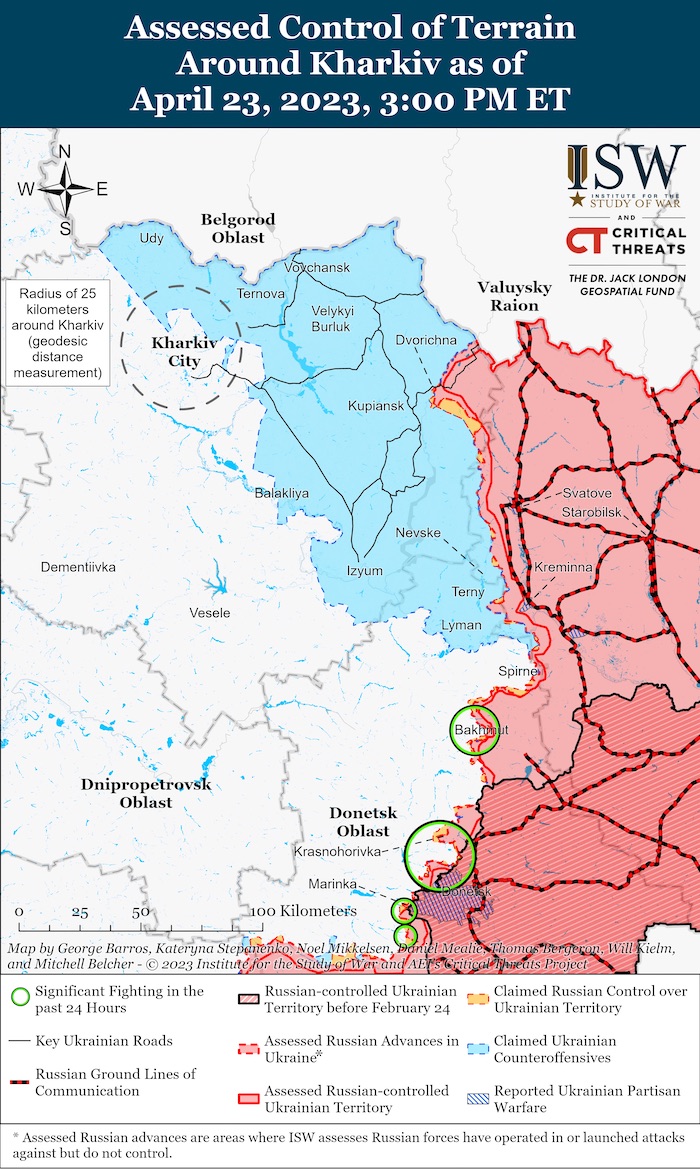
Svatove/Kreminna line
Russia has committed elements of two military districts and two airborne (VDV) divisions to an unsuccessful offensive in Luhansk Oblast that has operationally culminated. ISW assessed in February that WMD elements had been committed to decisive offensive operations along the Svatove-Kreminna line in Luhansk Oblast but forecasted that this offensive was extraordinarily unlikely to achieve meaningful gains. This offensive has now operationally culminated and has made only a few localized tactical gains. Elements of the WMD’s 20th Combined Arms Army (20th CAA); the Central Military District (CMD)’s 41st Combined Arms Army (41st CAA); VDV forces; the Main Directorate of the General Staff of the Armed Forces of the Russian Federation (GRU); forces of the Donetsk and Luhansk People’s Republics (DNR and LNR), and various ad hoc irregular formations have been fighting along the Svatove-Kreminna line since early 2023. ISW has observed a heavy commitment of the 20th CAA’s 144th and 3rd Motor Rifle Divisions (MRDs) along the Svatove-Kreminna line, including all three of the 144th MRD’s constituent regiments (the 254th and 488th Guards Motor Rifle regiments and the 59th Guards Tank Regiment) and two of the 3rd MRD’s motorized rifle regiments (the 752nd and 252ndMotorized Rifle Regiments).[10] Considering that most of these elements have been actively engaged in offensive operations along an active front for the greater part of four months they are likely exhausted and substantially degraded.
Russia has also committed elements of the CMD to the Svatove-Kreminna line, particularly in the area west of Kreminna. Geolocated footage posted in late February shows that elements of the 35th Separate Guards Motorized Rifle Brigade of the 41st Combined Arms Army (41st CAA) conducted a failed vehicle borne improvised explosive device (VBIED) attack against Ukrainian positions near Chervonopopivka, 6km north of Kreminna.[11] The 6th Tank Regiment of the 90th Tank Division is likely also engaged near Svatove, and a Russian milblogger noted in early January that mobilized servicemen of this regiment have been fighting in this area without rotation since October 2022, which suggests that the CMD largely lacks other forces with which to conduct necessary troops rotations.[12] The Russian Ministry of Defense (MoD) additionally refers to the “Central Group of Forces” (another name for the CMD grouping in Ukraine) operating in the Lyman direction west of Kreminna in its daily situation reports.[13] The CMD under Colonel General Alexander Lapin was responsible for the major Russian operational defeat following the Ukrainian liberation of Lyman on October 1, 2022.[14] CMD elements were likely severely degraded during the fall of Lyman and subsequent Ukrainian counteroffensive pushes, and the current CMD grouping near Kreminna is therefore likely comprised of partially reconstituted remnants of the October withdrawal. The exact hierarchy of command and control on this sector of the front is unclear-- Lapin was dismissed following the fall of Lyman but then apparently reappointed as commander of the Luhansk axis as of April 18.[15]
VDV forces are also actively engaged near Kreminna. ISW has observed mentions of the 237th Guards Air Assault Regiment of the 76th VDV Division and the 331st Guards Airborne Regiment of the 98th VDV Division operating in the forested area to the west and southwest of Kreminna.[16] The Russian military command notably appears to be increasing the prominence of VDV forces, and the Russian MoD reported on April 3 that VDV units received TOS-1A “Solntsepek” thermobaric artillery systems for the first time in history.[17] Geolocated footage confirms that Russian forces have used TOS-1A systems near Kreminna as recently as April 1.[18] TOS-1A systems are military district-level assets that are not tied to specific formations, so their use around Kreminna by VDV elements is noteworthy and suggests that the Russian military command may be trying to empower VDV units to conduct further offensive operations on this front. However, the commitment of a single type of artillery asset is unlikely to lend VDV forces a decisive offensive edge on this axis and does not replace the core requirement for better (and more) Russian infantry capabilities, as ISW has previously assessed.[19]
The Main Directorate of the Russian General Staff (GRU) has also deployed limited special forces (Spetsnaz) elements along the Svatove-Kreminna line, likely to offset the lack of needed infantry capabilities. Russian milbloggers have posted footage claiming that the 24th Separate Special Purpose Brigade and 3rd Guards Special Purpose Brigade are operating near Makiivka (22km northwest of Kreminna) and around Kreminna itself.[20] The Russian military continues to use Spetsnaz units to conduct ground attacks and infantry maneuvers instead of for their primary sabotage and targeting missions, as ISW has previously observed.[21] The apparent increased prominence of Spetsnaz units in this area is likely part of the Russian military command’s effort to mitigate losses to ground assault elements by committing elite formations that traditionally have different functions to regular combat missions.[22]
Several irregular Russian formations have additionally been playing a supplementary role along the Svatove-Kreminna line. LNR, BARS (Russian Combat Reserve), Chechen “Akhmat” Spetsnaz, and the “Don” Cossack Regiment appear to be participating in hostilities in this area, albeit to a much more limited extent than more conventional units.[23] ISW has observed two BARS detachments—BARS “Kaskad” and BARS-13—engaged near Kreminna, and the 4th LNR Brigade and 3rd LNR Battalion additionally have been fighting alongside Chechen “Akhmat” elements south of Kreminna near Bilohorivka.[24]
Russian forces have failed to make meaningful advances in Luhansk Oblast in 2023, despite the heavy commitment of elements of at least three armies of two military districts, elements of two VDV divisions, and the support of numerous irregular formations. The forces that have been fighting along this line for at the better part of four months are likely exhausted and substantially degraded. They have continued to attack, have not rotated to rest and refit, and do not appear to have prepared themselves to receive a Ukrainian offensive.
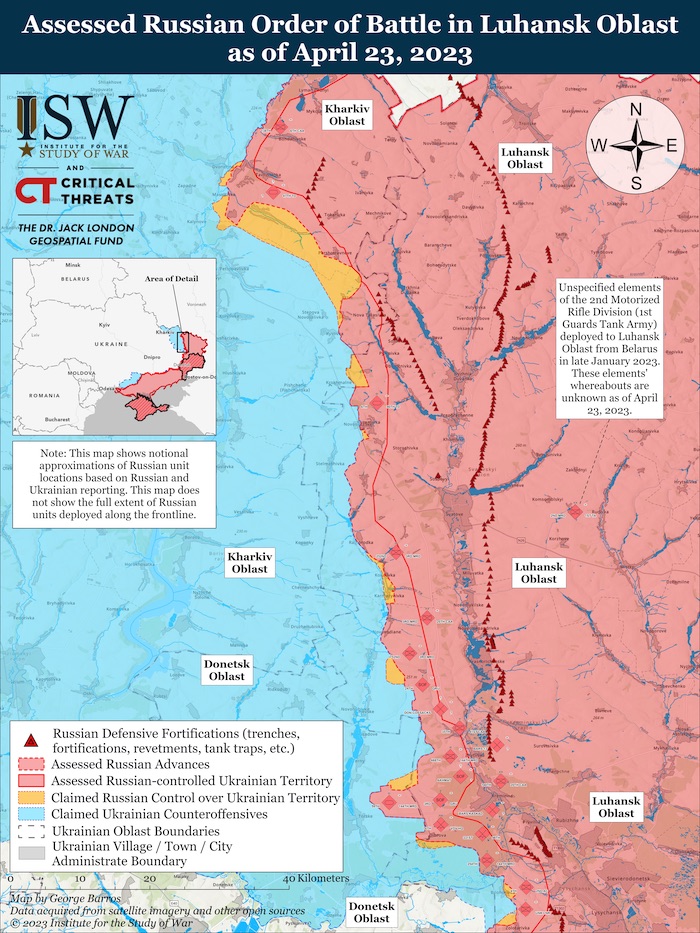
Observed elements:
- Spetsnaz
o 24th Separate Special Purpose Brigade [25]
o 3rd Guards Special Purpose Brigade [26]
- VDV
o 76th VDV Division
§ 237th Air Assault Regiment [27]
o 98th VDV Division [28]
§ 331st Airborne Regiment [29]
- 20th Combined Arms Army
o 144th Motor Rifle Division [30]
§ 254th Guards Motor Rifle Regiment [31]
§ 488th Guards Motor Rifle Regiment [32]
§ 59th Guards Tank Regiment [33]
o 3rd Motor Rifle Division [34]
§ 752nd Motorized Rifle Regiment [35]
§ 252nd Motorized Rifle Regiment [36]
- Central Military District
o 41st Combined Arms Army
§ 35th Separate Guards Motor Rifle Brigade [37]
§ 90th Tank Division
§ 6th Tank Regiment [38]
o Other unspecified echelons in the Lyman direction
- 2nd Luhansk Army Corps elements
o 4th Brigade [39]
§ TF SURRICATS anti-drone unit [40]
o 3rd Battalion [41]
- Irregulars
o BARS
§ BARS-13 [42]
§ BARS “Kaskad” [43]
o Chechen “Akhmat” Spetsnaz [44]
o Don Cossacks [45]
Bakhmut
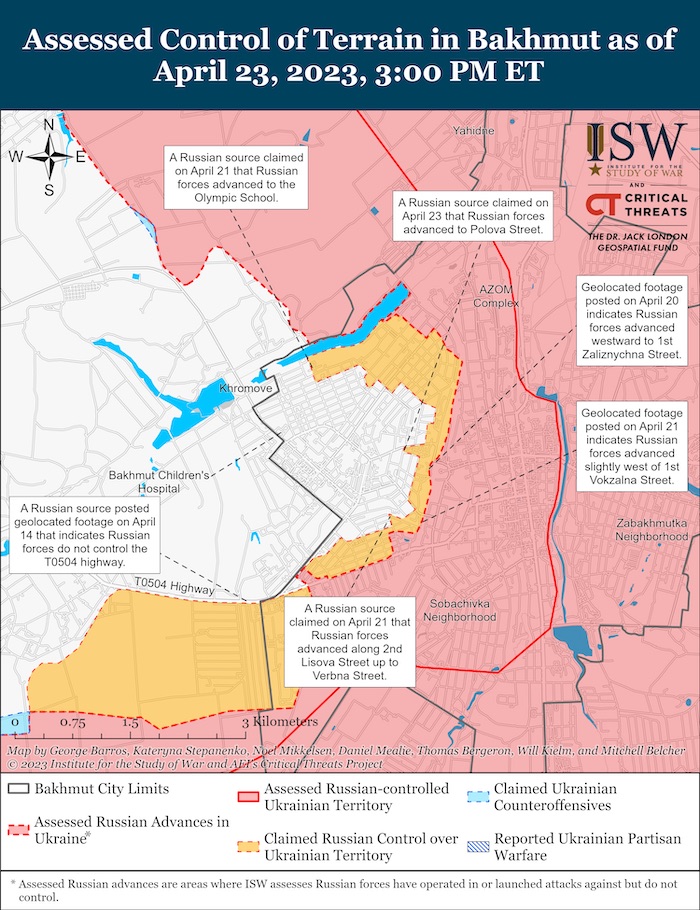
The current Russian pattern of commitment around Bakhmut suggests that the Russian military leadership is increasingly prioritizing the completion of the capture of the city before the start of the Ukrainian counteroffensive if possible. The Wagner Group continues to take heavy losses. It may well be able to complete the seizure of the city at some point. Sustaining Wagner’s advance beyond its culmination required the Russian MoD to commit VDV formations to allow Wagner to concentrate almost entirely on the urban fight. Wagner financier and chief Yevgeny Prigozhin ceded the northern and southwestern flanks to the Russian MoD and confirmed that VDV elements are supporting the Wagner main effort in Bakhmut in this way. VDV support in this area will likely enable Wagner to make more gains within the city and may persuade Ukrainian forces to withdraw. VDV units near Bakhmut are likely further removed from direct, highly attritional urban combat than Wagner elements, and will thus likely emerge from the battle for Bakhmut in substantially better shape than Wagner.
Russian milbloggers have noted that elements of the 106th VDV Division are defending the line near Yakovlivka, about 17km northeast of Bakhmut.[46] The announcement of Wagner and the VDV working together around Bakhmut suggests that the Russian military leadership is seeking to cooperate with Prigozhin despite previously growing frictions in order to expedite the capture of Bakhmut. The Russian MoD’s apparent desire to reduce friction with Wagner over Bakhmut is also evidenced by the apparent reappointment of former VDV commander and Wagner affiliate Colonel General Mikhail Teplinsky to an unspecified but “major” role in Ukraine after alleged previous disagreements with the MoD and Chief of the Russian General Staff Army General Valery Gerasimov.[47] These efforts on the command level are additionally having tactical impacts--Russian milbloggers noted that Wagner is now operating T-90 tanks in Bakhmut, which suggests that the Russian military leadership has allocated more modern assets to Wagner in an attempt to expedite the capture of the city.
Certain irregular Russian formations are also engaged near Bakhmut, although in a notably much more limited capacity than Wagner. The Ukrainian General Staff reported on February 25 that around 200 Chechen “Akhmat” special purpose police arrived in Bakhmut to combat desertion and sabotage by other Russian forces in the area.[48] “Akhmat” forces are unlikely to have engaged in actual combat, however. The “Lystan” volunteer detachment, part of the “Don” Cossack” formation, claimed to be fighting near Bakhmut as of March 18.[49]
Observed elements:
- Wagner [ISW does not attempt to maintain a detailed order of battle of Wagner forces]
o 11th Reconnaissance and Assault detachment [50]
- VDV
o 106th VDV Division [51]
- Irregulars/ volunteer battalions
o Chechen “Akhmat” Spetsnaz for military law enforcement within Bakhmut [52]
o Lystan volunteer battalion [53]
Avdiivka-Donetsk City axis
The Russian military command has heavily committed a variety of Donetsk People’s Republic (DNR) elements to the Avdiivka-Donetsk City frontline, alongside some Southern Military District (SMD) and Northern Fleet units. These elements have made no operationally significant progress on this axis in 2023 beyond marginal tactical advances around Avdiivka and within Marinka. DNR forces have notably been active along this axis since 2014, and the current frontline in this area is within kilometers of the line that has held for eight years.
DNR elements in this area have particularly suffered from poor and abusive command culture, which has been greatly exacerbated by the Russian MoD’s recent campaign to officially integrate and formalize DNR forces within the Russian military. The Russian military formally integrated and acknowledged control of the existing 1st and 2nd Army Corps (forces of the Donetsk and Luhansk People’s Republics, respectively), and these formations are now officially operationally subordinated to the 8th Combined Arms Army (Southern Military District).[54] This official subordination has caused widespread issues for DNR forces, however. Russian sources have circulated reports that the DNR command is sending mobilized servicemen from throughout Russia to fill out DNR units with minimal training and that DNR commanders badly mistreat mobilized servicemen and force them into attritional assaults with no preparation.[55] The Russian MoD’s desire to rapidly integrate DNR and Russian forces by staffing DNR units with Russian mobilized personnel has likely degraded the combat capabilities of forces on this front.[56]
DNR brigades, regiments, battalions, and other constituent elements notably are not manned or equipped in accord with normal Russian tables of organization and equipment. DNR forces initially started as militia-style proxy forces in 2014 and have maintained much of that irregularity within their formations despite their formal integration into the 8th CAA. The DNR calls certain formations “brigades,” “regiments,” or “battalions,” but these elements are not equivalent to Russian formations with the same echelon designation.
ISW has observed numerous DNR elements near Avdiivka and on the northwestern outskirts of Donetsk City. The DNR has heavily committed all eight of its known “brigades”—the 1stSlavic, 3rd Horlivka, 5th, 9th, 14thKalmius, 100th, 114th, and 132nd—to the area north and northwest of Donetsk City.[57] The 56th and 58th Separate Special Purpose Battalions, 10thTank Battalion, as well as the “Sparta” Separate Guards Reconnaissance Battalion and “Somalia” Separate Guards Assault Battalion have been prominent in DNR operations around Avdiivka and in the Vodyane area just southwest of Avdiivka.[58] A number of other DNR regiments are additionally engaged in this sector of the front.[59]
The SMD’s 8thCombined Arms army (8th CAA) has committed elements of both of its two motorized rifle divisions to operations in the Marinka area on the southwestern outskirts of Donetsk City. The 150th Motorized Rifle Division’s two tank regiments (68th and 163rd) and the 20th Guards Motorized Rifle Division’s 255th Guards Motorized Rifle Regiment have been fighting in Marinka since at least February 2023.[60] Mobilized servicemen from Krasnodar Krai posted a video appeal on March 9 in which they reported that they are serving in the 2nd Motorized Rifle Company (1st Motorized Rifle Battalion, 255th Motor Rifle Regiment) and that their command threw them into attritional assaults near Donetsk City (likely near Marinka) in late February.[61]
Elements of the Northern Fleet’s 14th Army Corps were also active in the Avdiivka-Donetsk City area but have likely withdrawn further into the rear due to high combat losses. Russian milbloggers claimed on March 22 that the 200th Separate Motorized Rifle Brigade (14th Army Corps, Northern Fleet) attacked Ukrainian positions near Tonenke, 7km west of Avdiivka.[62] Ukrainian Joint Press Center of the Tavriisk Direction Head Colonel Oleksiy Dmytrashkivskyi, however, reported on April 3 that the 200th Separate Motorized Rifle Brigade withdrew from the frontline in order to refit and recover.[63]
Several volunteer battalions are also reportedly fighting on the Avdiivka-Donetsk City axis. Russian sources have reported that the Perm Oblast “Molot” Tank Battalion, the “Wolves” Sabotage and Reconnaissance Battalion, and the “Nevsky” volunteer detachment are fighting near Avdiivka and in the Donetsk City area.[64] Dmytrashkivskyi noted on March 5 that the “Steppe” Cossack Battalion arrived at an unspecified area in the Donetsk City direction but reported that the “Steppe” Battalion was very distrustful of command and in panic.[65] Former Russian proxy commander and prominent critical milblogger Igor Girkin revealed on April 7 that the “Nevsky” volunteer detachment, which he enthusiastically advertised on his Telegram account, is essentially a sham that threw recruits into attritional assaults with no training or equipment and that its total complement is 1,186 despite the fact that it was advertised as a brigade (typically numbering approximately 3,200 to 3,600 personnel) .[66] Reports from both Russian and Ukrainian sources on irregular Russian formations operating in the Avdiivka-Donetsk City area suggest that these units are faced with pervasive issues of morale, organization, and command and are likely not particularly combat effective.
A reportedly captured Russian military manual offers insight into how 8th CAA and DNR forces are utilizing company-sized units in urban combat to mitigate limitations on the combat effectiveness of these formations as they fight along the Donetsk City line. A Ukrainian reserve officer released a captured Russian manual on April 6 that details the formation of “Storm Z” companies, which are staffed with recruits and created within elements of the 8th CAA and DNR.[67] These ”Storm Z” companies are staffed with 100 personnel (divided into four capture squads, four fire support squads, a command element, a combat engineering group, reconnaissance group, medevac group, and UAV crew) and are created outside the conventional army unit structure and attached to existing regiments and brigades.[68] These formations are meant to conduct urban combat operations or operations in challenging geographic areas with the intent of capturing strategic objects and are likely being employed in urban combat in highly fortified small settlements near Donetsk City. Their existence suggests that 8th CAA and DNR elements are so badly damaged that they need this sort of irregular tactical arrangement. Such ad hoc tactical formations integrated into already disorganized units are unlikely to lend Russian forces on this axis a significant offensive advantage.[69]
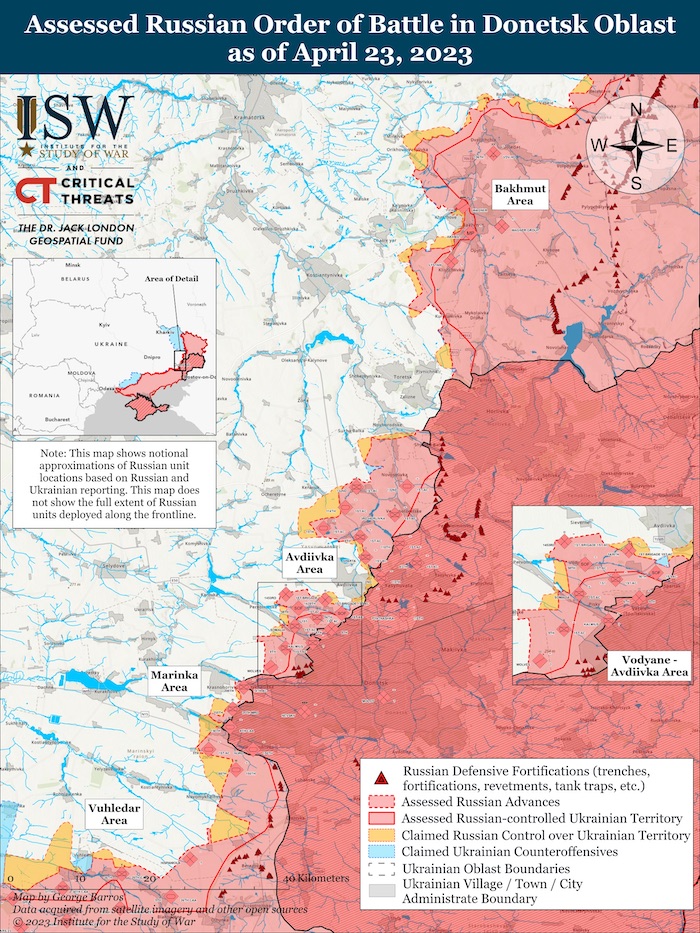
Observed elements:
- 1st Donetsk Army Corps elements
o 1st Slavic Brigade [70]
§ 1453rd Regiment [71]
§ 1439th Regiment [72]
o 3rd (Horlivka) Brigade [73]
o 9th Brigade [74]
§ 6th Rifle Battalion [75]
o 5th Brigade [76]
o 14th “Kalmius” Brigade [77]
o 110th Separate Guards Motorized Rifle Brigade [78]
§ 2nd Battalion [79]
§ Pyatnashka Battalion [80]
o 132nd Separate Guards Motorized Rifle Brigade [81]
o 9th Separate Naval Infantry Regiment [82]
o 10th Tank Battalion [83]
o 114th Brigade (formerly 11th Regiment) [84]
o 87th Regiment (formerly 9th Regiment) [85]
o 1454th Self-Propelled Artillery Regiment [86]
o 23rd Anti-Aircraft Missile Division [87]
o “Somalia” battalion [88]
o “Sparta battalion”[89]
o 56th Separate Special Purpose Battalion [90]
o 58th Special Purpose Battalion (previously 3rdSeparate DNR Special Purpose Brigade) [91]
o Unspecified DNR Spetsnaz elements [92]
- Southern Military District
o 8th Combined Arms Army
§ 150th Motorized Rifle Division [93]
§ 68th Tank Regiment [94]
§ 163rd Tank Regiment [95]
§ 20th Guards Motorized Rifle Division
§ 255th Guards Motorized Rifle Regiment [96]
§ 1st Motorized Rifle Battalion [97]
- Northern Fleet
o 14th Army Corps
§ 200th Separate Motor Rifle Brigade [98]
- Irregulars
o 3rd Army Corps
§ 72nd Separate Motorized Rifle Brigade [99]
o Volunteer battalions
§ Perm “Molot” Tank Battalion [100]
§ 1st Sabotage and Reconnaissance Battalion “Wolves” [101]
§ Nevsky Volunteer Detachment [102]
§ Steppe Cossack Battalion [103]
Southern Donetsk/Eastern Zaporizhzhia axis
Eastern Military District (EMD) elements have been committed to western Donetsk Oblast near Vuhledar since fall 2022 and have suffered continued losses during repeated failed attempts to take Vuhledar. The EMD’s 29th and 36th Combined Arms Armies (CAAs) and Pacific Fleet have been pursuing offensives towards Vuhledar over the course of the first few months of 2023.[104] An obituary posted on March 23 indicates that the 36th Separate Guards Motorized Rifle Brigade (29th CAA) fought in Mykilske, 4km southeast of Vuhledar.[105] Geolocated footage shows that a 36th CAA unit of unspecified echelon actively stormed Ukrainian positions near Mykilske in late February.[106] The 36th CAA’s 37th Separate Motorized Rifle Brigade and 5th Separate Guards Tank Brigade are also likely operating near Vuhledar.[107] Pacific Fleet elements, particularly the 40th and 155th Naval Infantry Brigades, have been the most actively engaged in this area since fall 2022.[108]
EMD elements in the Vuhledar area have been restaffed in various iterations with poorly trained and disciplined mobilized personnel to compensate for overall unit degradation. Following another notorious failed offensive on Vuhledar in early February 2023, Dmytrashkivskyi reported that naval infantry elements were losing 150 to 300 personnel per day and that the 155thBrigade therefore needed to be entirely restaffed for a third time.[109] Ukrainian intelligence also noted that elements of the 98th VDV Division arrived to support the 155th Naval Infantry Brigade around Vuhledar, further highlighting the destruction of this formation.[110] The failures of EMD units in this area have additionally been reflected on the strategic level—Russian sources speculated in late March that the Russian MoD dismissed EMD Commander Colonel General Rustam Muradov for command failures leading to operational disaster in western Donetsk Oblast.[111]
Limited DNR elements, a GRU brigade, several volunteer battalions, and a BARS detachment are also operating near Vuhledar. The “Kaskad” operational-combat tactical formation, comprised of DNR internal ministry and law enforcement personnel, has claimed that it is active in the Vuhledar direction.[112] A Russian milblogger posted a picture purportedly of a fighter from the GRU’s 14th Separate Special Purpose Brigade near Vuhledar.[113] The “Hispaniola,” “Alga,” and “Steppe/Tigr” battalions and BARS-23 detachment are also fighting in the area.[114] The “Hispaniola” Battalion is notably comprised of Russian sports fans and reportedly has been coordinating with the DNR “Vostok” Battalion, a militant formation formed in 2014 under the command of Alexander Khodakovsky.[115] “Alga” Battalion volunteers reported that they were charged with desertion after trying to leave the Vuhledar area upon the completion of their contracts, and the Ukrainian General Staff similarly reported that the Russian command has “lost control” over the “Steppe/Tigr” detachment near Vuhledar.[116] These reports suggest that volunteer elements near Vuhledar are likely poorly disciplined and are therefore combat ineffective.
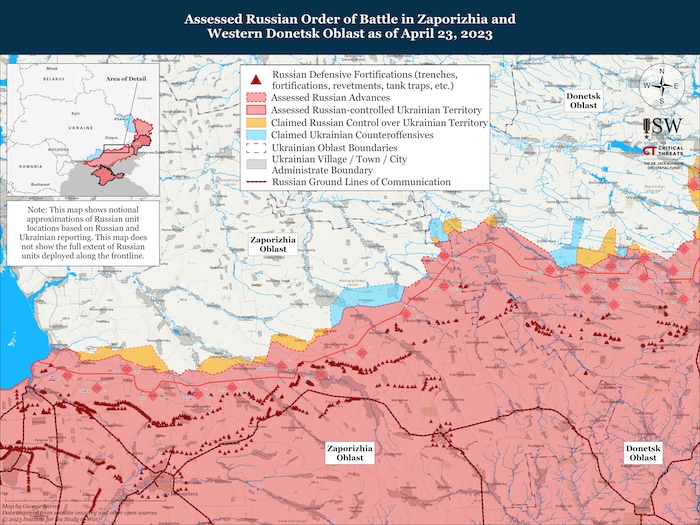
Observed elements:
- Eastern Military District
o 29th Combined Arms Army [117]
§ 36th Separate Guards Motorized Rifle Brigade [118]
o 36th Combined Arms Army [119]
§ 37th Separate Motorized Rifle Brigade [120]
§ 5th Separate Guards Tank Brigade [121]
o Pacific Fleet
§ 40th Naval Infantry Brigade [122]
§ 155th Naval Infantry Brigade [123]
o VDV
§ 98th VDV Division [124]
- GRU
o 14th Separate Special Purpose Brigade [125]
- DNR elements
o OBTF “Kaskad” [126]
- Irregulars
o Volunteer battalions
§ “Hispaniola” sports fans [127]
§ “Alga” battalion [128]
§ “Steppe/Tigr” Cossack battalion [129]
o BARS elements
§ BARS-23 [130]
Zaporizhzhia Oblast
Russia has committed SMD elements and several irregular formations to defensive operations in western Zaporizhzhia axis. Russian sources claimed that elements of the 58th Combined Arms Army (CAA)’s 42nd Guards Motorized Rifle Division—specifically its 70th and 291st Motorized Rifle Regiments—repelled a series of Ukrainian reconnaissance-in-force operations in the Zaporizhzhia direction on March 19.[131] A Russian milblogger noted that elements of the 291st Guards Motorized Rifle Regiment, including its 2nd Battalion, repelled Ukrainian attacks near Robotyne, about 55km southeast of Zaporizhzhia City.[132] Geolocated footage posted on March 20 confirms that a 291st Guards Motorized Rifle Regiment tank moved through Robotyne towards the frontline.[133] Russian milbloggers claimed that elements of GRU’s 22nd Separate Guards Special Purpose Brigade also defended against Ukrainian attacks on this sector of the front alongside 58th CAA elements, likely also near Robotyne.[134] Ukraine’s Main Military Intelligence Directorate (GUR) released an audio intercept on February 24 in which a Russian serviceman of the 19th Motorized Rifle Division’s 503rd Motorized Rifle Regiment says that his command ordered his unit to attack Shcherbaky, 33km southeast of Zaporizhzhia City.[135] Russian milbloggers have also highlighted the operations of the Black Sea Fleet’s 810th Guards Naval Infantry Brigade in the Zaporizhzhia direction.[136] One milblogger claimed that the 60th Motorized Rifle Brigade (EMD) is also active in this area.[137] However, the 60th Motorized Rifle Brigade became the 143rd Motor Rifle Regiment (127th Motorized Rifle Division, 5th CAA) in 2019, and it is unclear if the milblogger erroneously referred to the 143rd Motor Rifle Regiment as the 60th Brigade. The presence of EMD elements on this sector of the front is therefore low confidence.[138]
Numerous irregular formations are also present in Zaporizhzhia Oblast but are mainly engaged in defensive actions further in the rear. ISW has observed discussions about at least three volunteer battalions in the Zaporizhzhia direction. Zaporizhzhia Oblast occupation head Yevgeny Balitsky has notably formed his own “Sudoplatov” volunteer battalion, mainly comprised of foreign volunteers and individuals forcibly mobilized from occupied Zaporizhzhia Oblast.[139] The “Sudoplatov” battalion is active in Zaporizhzhia Oblast, but likely operating deeper in the rear. Russian sources have also claimed that the “Crimea” Battalion and the Ossetian “Storm” Battalion are active in the Zaporizhzhia direction.[140] Chechen Republic Head Ramzan Kadyrov stated on April 2 that personnel of the Chechen “South-Akhmat” Battalion are using UAVs to conduct reconnaissance of Ukrainian positions in the Zaporizhzhia direction.[141] A Russian milblogger reportedly visited a Bashkort mobilized regiment conducting defensive preparations in Zaporizhzhia Oblast on March 14 and claimed that the regiment had already built 37km of trenches in the rear.[142]
Russian forces in western Zaporizhzhia Oblast are likely less exhausted and degraded than forces elsewhere on the front due to the largely defensive nature of operations on this front so far in 2023.
While limited SMD and GRU elements have reportedly seen some active combat, most Russian forces in Zaporizhzhia Oblast are preparing for defense in depth. These troops are predominantly comprised of mobilized recruits and volunteers and are therefore likely to face some problems with poor training and discipline. They have, however, had more time on whole to rest and reconstitute following Ukraine’s 2022 southern counteroffensive.
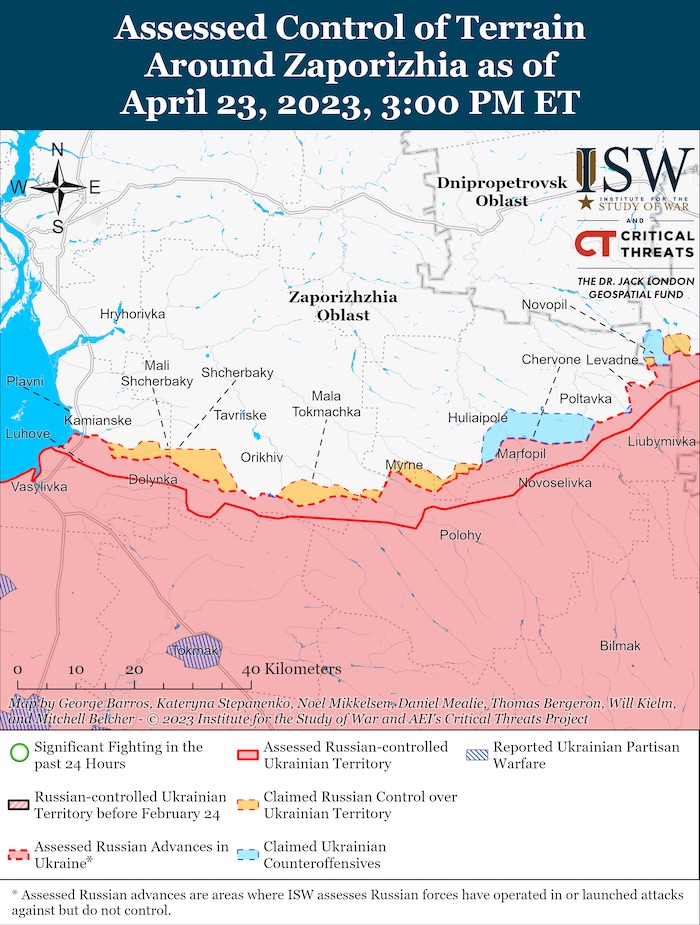
Observed elements
- Southern Military District
o 58th Combined Arms Army
§ 42nd Guards Motorized Rifle Division
§ 70th Motorized Rifle Regiment [143]
§ 291st Guards Motorized Rifle Regiment [144]
§ 2nd Battalion[145]
§ 19th Motorized Rifle Division
§ 503rd Motorized Rifle Regiment [146]
o Black Sea Fleet
§ 810th Guards Naval Infantry Brigade [147]
- Eastern Military District
o 5th Combined Arms Army
§ 127th Motorized Rifle Division
§ 143rd Motor Rifle Regiment (formerly the 60th Motorized Rifle Brigade)[148]
- Spetsnaz GRU
o 22nd Separate Guards Special Purpose Brigade[149]
- Irregulars
o Volunteer battalions
§ Yevgeny Balitsky’s “Sudoplatov” battalion [150]
§ “Crimea” battalion [151]
§ Ossetian “Storm” battalion [152]
o Random Wagner personnel[153]
o Chechen “Akhmat” forces [154]
Kherson axis
The Russian grouping in Kherson Oblast is likely the most disorganized and undermanned in the entire theater. Prior to the Russian withdrawal from the west (right) bank of Kherson Oblast on November 9-11, 2022, elements of the 76th and 106th VDV Divisions and 22nd Army Corps were committed to the area.[155] These elements have since been reconstituted and redeployed to other areas of the front. It is highly likely that the remaining grouping on the east (left) bank is mainly comprised of badly understrength remnants of mainly mobilized units. These elements have been removed from combat since the withdrawal in fall 2022, so they may be slightly fresher than elements elsewhere on the frontline. However, morale issues and poor training and discipline are likely common in this area, especially since more competent conventional elements are engaged elsewhere.
The information space in Kherson Oblast is notably very opaque, largely because this sector of the front has been mostly static since the Russian withdrawal from west bank Kherson in November 2022. The corps of military correspondents who report on frontline activities are elsewhere in Ukraine, so available information on the Russian grouping here is substantially limited. ISW has observed the presence of the 126th Coastal Defense Brigade of the Black Sea Fleet’s 22nd Army Corps near Velykyi Potemkin Island in the Dnipro River delta south of Kherson City.[156] Geolocated footage from February 18 additionally confirms that the 205th Separate Motorized Rifle Brigade (49th Combined Arms Army, SMD) was operating in Nova Kakhovka.[157] Crimean occupation head Sergey Aksyonov’s 300-person Wagner Group-affiliated “Convoy” private military company is also reportedly operating somewhere in Kherson Oblast.[158] It appears that the SMD has general responsibility for the Kherson sector of the front, but is less engaged here than it is in western Zaporizhzhia Oblast. Russian troops in Kherson Oblast, as in western Zaporizhzhia, are likely relatively less exhausted than forces elsewhere in theater and instead are preparing for defense in depth. However, the Russian grouping in Kherson is evidently scattered and undermanned.
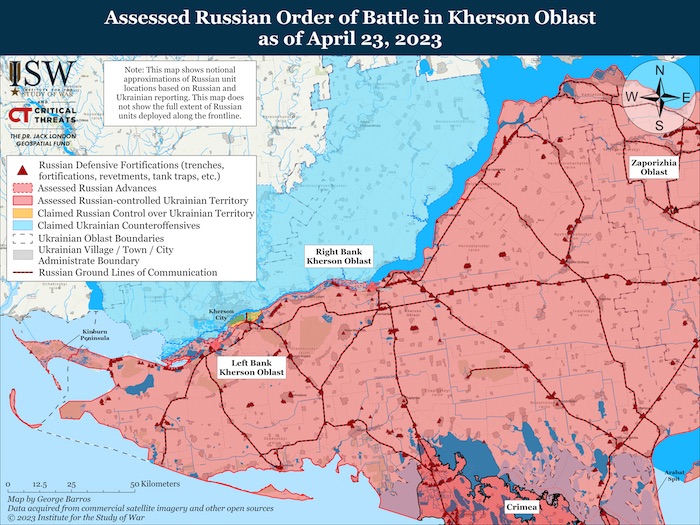
Observed elements:
- Black Sea Fleet
o 22nd Army Corps
§ 126th Coastal Defense Brigade [159]
- Southern Military District
o 49th Combined Arms Army
§ 205th Separate Motorized Rifle Brigade [geolocated to Nova Kakhovka] [160]
Black Sea Fleet Naval Capabilities
The Russian military command may commit ships of the Russian Black Sea Fleet (BSF) to supporting Russian troops attempting to defend in southern Ukraine, especially as operations move toward the coast. The BSF is unlikely to make a material difference in ground operations, however. Ukrainian forces have damaged all three Admiral Grigorovich-class BSF frigates: “Admiral Grigorovich, “Admiral Essen,” and “Admiral Makarov,” and the immediate status of the “Essen” and “Grigorivich” is unclear.[161] Satellite imagery from February 10, 2023, may suggest that the “Grigorovich” sailed to Sevastopol.[162] Krivak-class patrol ships “Ladnyi” and “Pytlivyi” have been participating in exercises in the Black Sea in 2023.[163] The BSF’s 197th Assault Ship Brigade is comprised of two Alligator-class, three Ropucha-I, and one Ropucha-II landing ships, all of which have been reported as active as of summer 2022.[164] These landing ships are the most relevant asset in terms of direct strike capabilities because they carry ground attack missile systems. The BSF also has an assortment of corvettes, minesweepers, antisubmarine ships, missile boats and landing ships in the Black Sea. These ships are unlikely to provide Russia a substantial defensive edge against any future Ukrainian counteroffensives into southern Ukraine, however, as they would likely need to move close enough to the coastline that they would make themselves attractive targets. Russian ships are primarily focused on anti-air, anti-ship, and anti-submarine missions, moreover, and generally do not carry many munitions appropriate for defending against mechanized counter-offensive operations.
The Russian obsession with continuing small-scale tactical offensive operations past the point of operational culmination has left Russian forces ill-prepared to respond to a large-scale mechanized counter-offensive. Russian forces have been prioritizing small-scale frontal assaults in order to make incremental tactical gains and reinforce small-scale tactical successes on limited areas of the front. These small-scale attacks do not require particularly involved command and control capabilities as local commanders can likely choose particular units or groups of individuals for attacks at times and places of their choosing and then focus their attention on those localized operations. Defensive maneuvers against a large-scale counter-offensive are much more complicated and will require involved and careful exercise of command and control over large units and large areas. Attacking Ukrainian forces will determine the times and places at which fighting occurs and will likely press across much wider areas than the attack sectors Russian commanders have typically focused on. Russian commanders will likely have to rely on all their units and sub-units fighting, not a chosen few, and will likely have to coordinate the defensive operations of all their units at the same time, rather than concentrating on a sector of their choice. The experience of combat that most Russian tactical and even operational commanders have is thus unlikely to prepare them well for the challenges they are likely to face.
The majority of the Russian units in important sectors of the front have been filled out with mobilized servicemen who were called up following Ukraine’s successful Kherson and Kharkiv Oblast counteroffensives and have not had experience defending against or withdrawing from a mechanized, multi-brigade advance, moreover. They are unlikely to be emotionally or intellectually prepared to respond to such an assault regardless of combat experience they have gained in the offensive operations of which they have hitherto been part. Sound defense and retrograded withdrawal will also likely be complicated by pervasive and endemic issues with morale and discipline of Russian forces. ISW has reported on many previous instances of servicemen in different areas of the front complaining about conditions within their units, abuse at the hands of commanders, dismissive command attitudes towards casualties, and desertion.[165] These factors are detrimental to unit cohesion and will likely further degrade overall Russian defensive capabilities.
The array of Russian fortifications throughout the theater is indicative of the defensive maneuvers Russian forces may have prepared to conduct. Russian forces have constructed a hard line of fortifications along the Kharkiv-Luhansk Oblast line at a distance of between 5 and 20 kilometers behind the front line with the bulk of Russian combat power deployed forward of its fortification lines all along the front. This array suggests that Russian forces intend to withdraw from the frontline to the fortification line and defend there in case of a Ukrainian breakthrough. Similarly, the lines of fortifications in the Bakhmut and Donetsk City area are 5 to 20 kilometers behind the current line of contact, in principle leaving Russian forces space to withdraw through a buffer zone and man a system of defenses behind the line. Defensive lines in southern Ukraine, however, look very different. Russian forces in southern Ukraine have ostensibly prepared for defense in depth, with multiple lines of fortifications that go further into the rear. These defensive lines are mostly likely not all heavily manned—Russian forces simply do not have the personnel to properly man fortifications in areas far removed from the frontline at force densities sufficient to withstand a determined mechanized attack. Successful Russian defense in depth will likely require that Russian forces instead coordinate multiple retrograde maneuvers to fall back on each subsequent line of defense, which will require a high level of motivation and discipline among troops and sound command and control to oversee the complex and dangerous operation. Russian forces also suffer from significantly degraded mechanized maneuver capabilities and would likely be retrograding to secondary defensive lines largely by foot in the face of any potential mechanized Ukrainian counteroffensive push.
The current Russian ORBAT in Ukraine suggests that there are very few Russian units that are not actively online in the theater and emphasizes the widespread losses that Russian conventional elements have suffered throughout the war so far. The Russian military has 12 combined arms armies. ISW has observed reports of elements of all but two armies in operations so far in 2023—the EMD’s 35th CAA and the CMD’s 2nd CAA. Russian milbloggers reported that the 35th CAA was essentially completely destroyed by Ukrainian forces near Izium in June 2022, and remnants of the 35th CAA reportedly deployed to west (right) bank Kherson Oblast to defend against Ukrainian counteroffensives in the summer of 2022.[166] It is therefore likely that remnants of the 35th CAA are scattered throughout southern Ukraine (particularly in rear Kherson Oblast and around critical areas in rear Zaporizhzhia Oblast) or even elsewhere in the theater and have likely been deployed in formations that are neither doctrinal nor at effective combat capability. The 2nd CAA has likely suffered losses similar to those of the 35th CAA. Ukrainian sources reported in April 2022 that elements of the 2nd CAA redeployed to Russia following the Russian withdrawal from Kyiv Oblast.[167] Elements of the 2nd CAA thereafter deployed in more piecemeal formations to the Izium area in Kharkiv Oblast and likely suffered substantial losses during Ukraine’s autumn 20222 Kharkiv Oblast counteroffensive and around Lyman, Donetsk Oblast, in early October.[168] The Russian MoD’s daily situation reports mention CMD formations in the Lyman direction, which may mean that elements of the 2nd CAA and other CMD units are operating in this area but are so understrength that they cannot be counted as formal elements.
The pattern of Russian deployments throughout Ukraine strongly suggests that most of the available maneuver elements of all military districts, as well as major surviving Airborne forces, are already committed to either active offensive or defensive operations in Ukraine. Russia will need to commit significant reserves to any discrete axis in order to conduct effective offensive operations, and the generally exhausted condition of troops and the apparently disorganized and fragmented deployment pattern in some areas will likely pose significant obstacles to Russia’s prospects for defending critical sectors of the frontline.
Key inflections in ongoing military operations on April 23:
- Wagner Group financier Yevgeny Prigozhin claimed that he ordered Wagner Group personnel not to capture Ukrainian prisoners of war (POWs) but instead only kill Ukrainian personnel on the battlefield.[169]
- The Ukrainian General Staff reported that Russian forces did not conduct offensive operations along the Kupiansk-Svatove-Kreminna line on April 23.[170] Ukrainian Sievierodonetsk Raion Administration Head Roman Vlasenko reported that Russian forces are building fortifications around Severdonetsk and other large cities in Luhansk Oblast.[171]
- The Ukrainian General Staff reported that Russian servicemen and Wagner personnel engaged in a shootout in Stanytsia Luhanska, Luhansk Oblast following a dispute about responsibility for tactical miscalculations and losses.[172]
- Russian forces continue to conduct ground attacks in and around Bakhmut and along the Avdiivka-Donetsk City front.[173] Ukrainian Joint Press Center of the Tavriisk Defense Forces Spokesperson Colonel Oleksiy Dmytrashkivskyi reported on April 23 that Russian forces concentrated most of their efforts in the Avdiivka direction and conducted 28 assaults in the Donetsk direction.[174]
- Geolocated footage published on April 23 indicates that Ukrainian forces are operating in areas northwest of Oleshky on the east (left) bank of the Dnipro River in Kherson Oblast.[175] Kherson Oblast Occupation Administration Head Vladimir Saldo denied that Ukrainian forces have established a bridgehead on the east (left) bank as of April 23.[176]
- The Ukrainian Resistance Center reported on April 23 that Russian forces are planning to mobilize migrants from Central Asia by threating to deport migrants and revoke their Russian citizenship if they do not fight in the war.[177]
- Ukrainian Kherson Oblast Administration Advisor Serhiy Khlan stated on April 22 that Wagner Group fighters are helping Russian occupation officials assert control over the civilian population on the east (left) bank of the Dnipro River in Kherson Oblast.[178]
- A Belarusian military news outlet claimed that Belarusian forces plan to deploy Russian tactical nuclear weapons to bases where mobile launch complexes were previously located before the withdrawal of nuclear weapons from Belarus from 1993 to 1996.[179]


